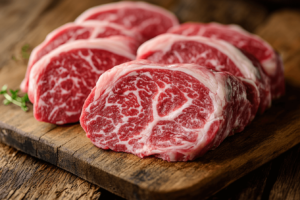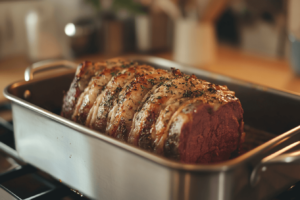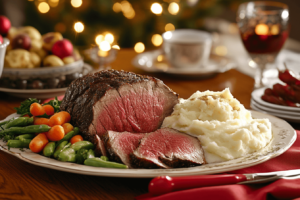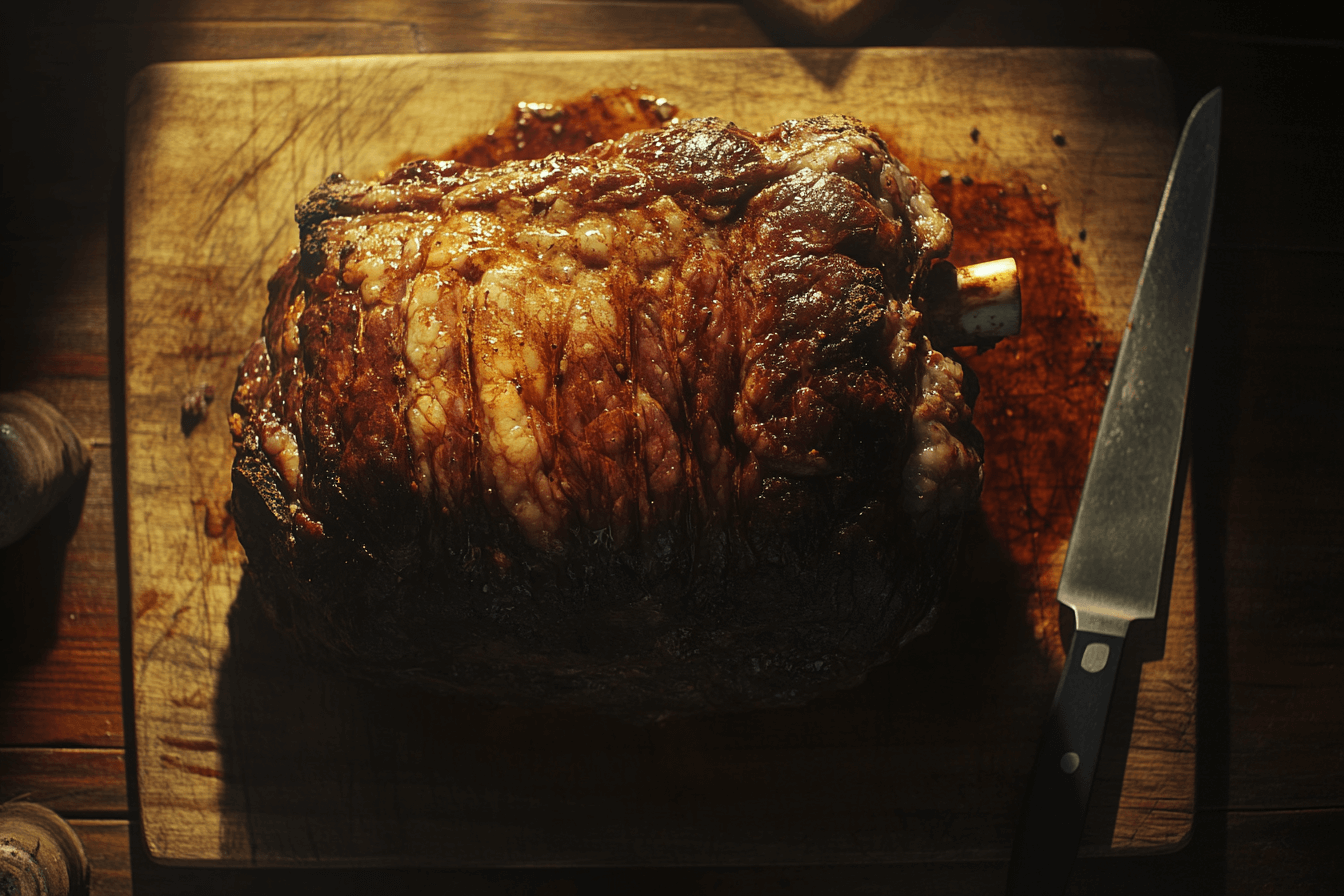If you have ever strolled through the meat section at your local grocery store, you may have wondered whether a ribeye roast is the same as prime rib. Many people get confused because these cuts come from the same part of the cow. However, there are subtle differences. Understanding those differences is key to choosing the right cut for your next gathering. Moreover, you want the best flavor for your table. In this article, we will explore the meaning of a ribeye roast, the definition of prime rib, how these popular roasts compare, and the most effective ways to cook them. Keep reading to learn more about these mouthwatering options, so you can confidently prepare a memorable meal for your loved ones.
Understanding the Ribeye Roast
A ribeye roast comes from the rib section of the cow. It is typically taken from the sixth to the twelfth rib. Furthermore, it is known for its marbling, which helps it stay juicy and tender during cooking. This cut is often available as a boneless rib roast, which makes carving easier. Yet, many people still choose a standing rib roast, with the bones attached, to enhance the flavor.

Boneless Rib Roast Basics
A boneless rib roast lacks the bones. Therefore, it is simpler to slice and serve. Additionally, its compact shape helps it cook more evenly. Yet, some fans claim that bones act as insulation and may boost the beefy flavor. Regardless of whether you opt for a bone-in or boneless cut, a ribeye roast is beloved for its intense taste and tenderness.
Where the Ribeye Name Comes From
The name “ribeye” reflects the prime location of the roast. It centers around the “eye” of the rib, which is the heart of the meat. This area remains tender because it does not get the same workout as other muscles. Moreover, the ribeye roast typically displays a rich, beefy taste. In many ways, it is a luxurious choice for home cooks looking to impress.
Understanding Prime Rib
Prime rib is also known as a standing rib roast when it still has the bones attached. It can be boneless too, though most people enjoy cooking it bone-in to boost its flavor and presentation. Prime rib is often tied or left “standing” in the roasting pan, with the bones forming a built-in rack. Because it usually includes the outer lip of the rib and the eye of the rib, prime rib is more than just a single eye. It contains multiple muscle groups, which can offer a contrasting texture and taste.

Standing Rib Roast
A standing rib roast is another name for prime rib that is cooked with the bones intact. Additionally, the bones help protect the roast from direct heat. As a result, the meat cooks evenly, retaining plenty of juices. Plus, a well-roasted prime rib can deliver a dramatic centerpiece for special occasions or holiday feasts.
Why “Prime” in Prime Rib?
The term “prime” in prime rib refers to its popularity as a top-quality cut, but it does not always indicate that it is USDA Prime grade. Indeed, prime rib can be available in several grades, such as Choice or Prime. Nevertheless, prime rib is recognized for its robust flavor and excellent tenderness.
Differences Between a Ribeye Roast and a Prime Rib Roast
Is a ribeye roast the same as prime rib? They come from the same primal section of the cow, yet there are specific factors that set them apart. Consequently, knowing these key differences helps you decide which roast suits your needs.
Bone Structure
Prime rib, often referred to as a standing rib roast when bone-in, retains the bones for cooking. In contrast, a ribeye roast tends to be boneless, though you can find bone-in versions too. Indeed, some butchers label a boneless ribeye roast differently than a traditional prime rib, even if they are closely related.
Size and Presentation
In many cases, prime rib is sold in larger pieces. This big roast is great for holiday dinners. On the other hand, a ribeye roast is often sold in smaller sizes, making it more suitable for intimate meals or smaller families. Moreover, prime rib often includes that extra layer of fat and the adjacent muscle, while a ribeye roast focuses on the “eye” portion.
Cooking Intentions
Although both cuts are equally mouthwatering, prime rib is frequently chosen for celebrations and served as a formal centerpiece. Meanwhile, a ribeye roast can be a convenient option for weeknight dinners or more casual gatherings. Still, both are delicious enough for any special event.
Cooking Methods for Ribeye Roast and Prime Rib
When it comes to cooking a succulent roast, choosing the right technique matters. After all, you want a perfect crust on the outside and a juicy, tender interior.
Roasting Technique
Whether you are making a prime rib or a ribeye roast, roasting in the oven is the most popular method. Preheat your oven to a high temperature, sear the roast for a short period, then lower the temperature and cook until it reaches your desired doneness. This approach allows the crust to form while the interior cooks slowly.
Grilling or Smoking
Although less common, grilling or smoking a ribeye roast or a prime rib roast can bring out deep, smoky flavors. Be cautious to maintain a consistent temperature. Moreover, use a reliable meat thermometer to ensure you do not overcook your roast. This method adds a tasty layer of complexity and is worth exploring if you love outdoor cooking.
Recommended Seasonings
Salt and pepper are a classic choice for seasoning prime rib and ribeye roasts. However, garlic, rosemary, and thyme also work well. Always let the roast rest after cooking. This step allows the juices to redistribute, which keeps every slice tender and moist.
Marbling, Flavor, and Serving Tips
The secret to a mouthwatering beef roast lies in its marbling, or the intramuscular fat that melts away during cooking. Moreover, this fat ensures a rich flavor and moist texture.
Marbling
Ribeye roasts, especially USDA Prime or Choice, tend to have abundant marbling. Consequently, they remain juicier compared to other cuts. Prime rib also boasts generous marbling, but it may include more outer layers of fat surrounding different muscle groups. While that extra fat can boost flavor, it may not appeal to everyone.
Flavor Profile
Ribeye roast delivers a bold, beefy flavor due to its central location on the rib primal. It is generally slightly more uniform in texture. Prime rib, on the other hand, contains a blend of different muscles. This results in diverse textures and fat levels in each bite. Although both roasts are delectable, some people prefer the consistent bite of a ribeye roast. Others enjoy the variety found in prime rib.
Serving Suggestions
Both prime rib and ribeye roast pair well with creamy horseradish sauce. Additionally, au jus or a rich red wine sauce can enhance the natural flavors. Complement your roast with sides like mashed potatoes, roasted vegetables, or a fresh garden salad. Because of their hearty taste, these roasts hold up against a wide range of side dishes. Moreover, a bright acidic condiment or a crunchy salad can balance the richness of the meat.

Nutritional Aspects of Ribeye Roast and Prime Rib
Beyond flavor, considering the nutritional profile might be important for health-conscious eaters. Although both roasts are high in protein, they also contain noticeable fat. However, with moderate serving sizes, they can still fit into a balanced diet.
Protein Content
Ribeye roast and prime rib are excellent sources of complete protein. Additionally, they contain essential amino acids that support muscle development and overall health. Eating them in reasonable portions can be part of a well-rounded meal.
Fat Content
Due to marbling, these roasts have higher fat levels than leaner cuts. However, trimming some of the exterior fat and choosing moderate serving sizes can help you manage fat intake. If you want a leaner approach, consider a smaller portion and load up on veggies to add fiber and vitamins.
Vitamins and Minerals
These beef roasts supply iron, zinc, and B vitamins. Furthermore, these nutrients help support energy levels and immune function. However, it is wise to balance these benefits with the roast’s saturated fat content.
Purchasing, Storing, and Preparing the Perfect Roast
Selecting the ideal roast involves more than just deciding between ribeye roast or prime rib. You should also think about grade, quantity, and how you plan to store and prepare the meat.
Choosing USDA Grade
You may encounter terms like USDA Prime, Choice, or Select. Prime meat often shows the highest level of marbling and flavor, but it comes with a higher price tag. Choice is a popular middle ground, delivering good marbling at a friendlier cost. Meanwhile, Select is leaner but still an option if you are on a budget.
Estimating Portion Size
A key concern when purchasing a large roast is portion size. Generally, aim for about one pound of raw meat per person. This estimate allows for shrinkage during cooking and ensures everyone gets a hearty serving. Moreover, a bone-in roast often requires a bit more meat to ensure ample portions.
Proper Storage
Keep your roast in its original packaging until you are ready to season it. Store it in the coldest part of your refrigerator. If you need to freeze it, wrap it tightly in plastic wrap or freezer paper. Then, place it in a freezer-safe bag to prevent freezer burn. Thaw the roast in the refrigerator before cooking to maintain the best texture and taste.
Step-by-Step Guide to Cooking a Ribeye Roast or Prime Rib
Preparing these cuts at home can be simple if you follow some proven techniques. Below is a step-by-step outline to ensure your roast turns out spectacular every time. Use these steps as a foundation. Then, feel free to add your own culinary flair.
- Preheat Your Oven
Set your oven to a high temperature (around 450°F). Preheating helps form a flavorful crust on your roast. - Season Generously
Pat the roast dry with paper towels. Then coat it with salt, pepper, and any additional herbs you prefer. Let it rest at room temperature for 30 minutes to an hour. - Sear at High Heat
Place the roast in a roasting pan and insert it in the oven. Sear it at 450°F for about 15 minutes. This step locks in the juices and promotes browning. - Reduce Heat and Continue Cooking
Lower the oven temperature to around 325°F. Continue cooking until the internal temperature hits your target doneness. For medium-rare, aim for 130°F to 135°F. A reliable meat thermometer is crucial for accuracy. - Rest the Roast
Remove your roast from the oven and tent it loosely with aluminum foil. Allow it to rest for 15 to 20 minutes. This rest period redistributes the juices, ensuring every slice is tender. - Carve and Serve
Carefully slice your roast against the grain. Serve it with your choice of side dishes and enjoy! Remember, leftover slices make for fantastic sandwiches the next day.
Flavorful Variations and Additional Cooking Tips
Experimenting with rubs and cooking methods can help you discover new ways to enjoy these roasts. Because both prime rib and ribeye roast respond well to bold seasonings, do not be afraid to get creative.
Herb Crust
Create an herby crust by mixing chopped fresh herbs like rosemary, thyme, and oregano with minced garlic, softened butter, salt, and pepper. Pat this mixture all over the roast before searing. The herbs will infuse the meat with fragrant flavors.
Reverse Sear Method
In the reverse sear approach, you start by cooking your roast at a low temperature (around 225°F). Then, once the internal temperature is about 10°F below your target, you remove the roast and let it rest. Finally, you finish it in a hot oven or on a grill to form a crisp crust. This method allows the meat to cook evenly and remain juicy.
Smoking with Wood Chips
If you own a smoker, adding hickory or oak wood chips provides a pleasant smoky scent. Low and slow cooking can take longer, but the result is a unique flavor profile that stands out from traditional roasts. Because smoke penetrates well, you might need minimal additional seasoning.
Frequently Asked Questions
Can you use beef ribeye for prime rib?
Yes, you can use a beef ribeye roast as prime rib since they come from the same part of the rib section. However, the main distinction lies in presentation. Prime rib is often served bone-in, while a ribeye roast is usually boneless.
What is a prime rib called at the grocery store?
Many groceries label prime rib as a standing rib roast, especially when it still has the bones attached. You may also see the term “rib roast” used as a catch-all. Always confirm with your butcher to ensure you purchase the correct cut.
What is ribeye roast also known as?
Ribeye roast can go by different names, such as boneless rib roast or sometimes just rib roast. Additionally, if sold with the bone-in, it can resemble a standing rib roast.
What is the difference between a ribeye roast and a prime rib roast?
Both cuts come from the same primal area. Yet, prime rib often implies a larger roast cooked bone-in, while a ribeye roast is commonly boneless. They have many similarities, but certain muscle structures and sizes can vary.
Conclusion
Deciding between a ribeye roast and prime rib roast does not have to be complicated. They share a common origin yet still differ enough in structure and presentation to impact your cooking plans. If you crave a roast that showcases uniform marbling and a straightforward serving process, a ribeye roast could be your best option. Alternatively, if you want a show-stopping centerpiece that often includes the bones and multiple muscle groups, then prime rib might be a perfect fit. Regardless of which roast you choose, both promise a succulent, beefy feast. With the right cooking approach and seasonings, you can make an unforgettable meal. Enjoy exploring these flavorful cuts as you hone your roasting skills.

